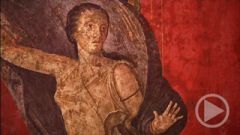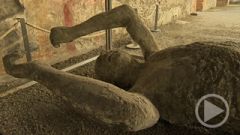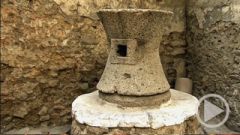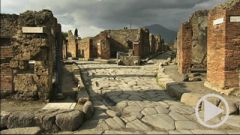Brothels and Baths, Taverns and Theaters
Baths and Brothels, Taverns and Theaters
The men’s world of Pompeii placed a high value on virility and potency. Phalluses are everywhere – even in the streets. The phallus is a fertility symbol and as an amulet it wards off the evil eye and grants wealth.
The archaeologists who excavated here in the 19th century were shocked to find phalluses everywhere. Was Pompeii full of brothels? Indeed, there are lots of advertisements by prostitutes who offered their services in taverns or the public baths. But are erotic paintings in some back room necessarily a sign of a certain type of establishment?
In fact, there’s only a single house that must have been a brothel. The drawings over the doors are unambiguous – perhaps they are catalogues of what’s on offer? In one corner is a toilet and then five cabins downstairs and as many again on the upper floor. They’re not very romantic, even if we imagine pillows and soft furs on the couches. The prostitutes were slaves from foreign countries. Their services were quick and cheap. Having sex cost about as much as a good flask of wine.
Once again the rich satisfied their needs at home – where sexual relationships with slaves were seen as perfectly normal – while the less wealthy came here. But the customers did get satisfaction, as attested to by hundreds of pieces of graffiti on the walls.
A major public meeting place is the baths. In the Roman Empire it’s usual for people to hold appointments in the nude. A visitor to the bath leaves his things in the niche in the wall – though preferably not his valuables. They’re likely to be stolen, as even Roman writers report.
The rooms of the baths are places of splendour – palaces for the people. Everyone comes here to relax, from slaves to senators. Even the emperor will occasionally put in an appearance in the public baths of Rome. The Suburban Baths of Herculaneum are among the best preserved ones in the world, and they also demonstrate the terrible power of the volcano. Here, too, wooden doors were conserved by the ash.
The central furnace not only warmed the water, but heated the floor. This ingenious system was invented here in Campania, and from here it spread through the entire Empire. It features double floors and walls with ducts through which hot air circulated.
In the evenings, after work, the people of Pompeii headed to the taverns. A publican had some everyday vignettes drawn on the wall like a comic strip: The server brings an eagerly awaited glass of wine. “Here!“, calls the guest on the left. “No, that’s mine!”, shouts the one on the right. The server doesn’t seem to care one way or the other: “Whoever wants it – take it.”
Next we see a somewhat tentative love scene – or perhaps the end of it? “With Myrtalis, I don’t want to…”, says the man. But we will never know exactly what he doesn’t want to do with Myrtalis.
One of the most popular vices in Pompeii was gambling. But even over dice there were differences of opinion. “I won!“ – “That’s not a three, it’s a two!” The final picture once showed the two men coming to blows over the dice. Only the inscriptions have been preserved, with a couple of vulgar insults. But the tavern-keeper has the last word: ”If you want to fight – get out!” The passion for games was a bond between rich and poor – dice have been discovered in cheap taverns as well as in the wealthiest homes.
Wine and dice are one way to spend an evening – but for a real treat Pompeians go to the theater. Pompeii had a theatre long before the capital Rome did. Our old friend Marcus Holconius Rufus had the old building restored and enlarged – until it accommodated five thousand people, nearly half the population of Pompeii. "They come to see, they come to be seen," wrote Ovid, the great poet. He meant not only the women in their fashionable robes, but also the elegant men.
Poorer citizens, women and slaves sit in the upper rows of seats. From here they can cheer the actors on stage - and their rich patrons. The patricians have places reserved for them in the lower rows. The broad entryways next to the stage let them play to the gallery. There’s a separate entrance for the common people – right next to the one for the elite – but narrower and steeper.
The people of Pompeii must have been obsessed with the theatre; everywhere in the town we find images of the typical masks. At the same time, the actors’ profession was considered dishonorable. It put them on the same level as prostitutes but also as the greatest stars of the entertainment business – the gladiators.
Their stage is the amphitheatre. Here, too, the common people have to climb to the upper levels, while wealthy patrons have their own entrances to the seats below. In the year 79 most of the seats are still made of wood – and are only gradually being replaced with stone benches.
The fighters make their triumphal entrance through the wide portals. The spectacle begins with a hunting scene featuring wolves and bears. Most likely, lions never made it to Pompeii – to see them one had to travel to Rome. And even the gladiator fights were not as bloody as we imagine them today. The fighters were not automatically doomed to die.
Prof. Karl-Wilhem Weeber, Wuppertal/Witten:
"Ultimately the audience decided the fate of a gladiator who had lost. Of course it happened that someone would be fatally wounded in the fight. But if he lost – that is, had to give up – but had fought bravely and “put on a good show”, then the audience would usually let him go."
The victors often became celebrities – and not only to the lower classes. Even here in the theatre entrance for the wealthy a fan immortalized his idols for posterity. The fans keep statistics on their heroes’ victories and celebrate them – like here in the peristyle of the House of the Ceii.
Women are among the enthusiasts, too. The champions may be despised, rough, violent – but they are real men. Most of them are slaves or condemned criminals. However, such is their fame that again and again there are also freeborn Romans who become gladiators – and ‘temporary slaves.’
A gladiator performs five or six times a year. The rest of the time he lives and trains here in the gladiators’ barracks, as a member of a troop belonging to a master, or Lanista. These troops were also known as familia – and often the opponents in the arena were actually friends. Another reason why they were generally not inclined to kill each other. And their owners didn’t like to see them die, either.
Prof. Karl-Wilhem Weeber:
"In general, the gladiators had outstanding training. In other words, a great deal had been invested in preparing them, so if a gladiator died it was a considerable financial loss."
Again it was the rich people who sponsored gladiator events. The spectacles were very costly, but good for the patron’s image. The more generous sponsors even paid for awnings over the arena – a move which made them very popular.
There is space for 22 thousand people in the amphitheatre – considerably more than the number of residents of Pompeii. It is an entertainment centre, attracting audiences from farms and neighbouring towns in the entire region.
As can be expected among neighbours, there are long-standing rivalries. And sometimes they explode – as they did in 59 AD. This fresco tells the story: Many spectators had come from the neighbouring town of Nuceria to see a gladiator show. In the foreground all is normal: street vendors offer snacks and souvenirs for sale, women stroll under the trees. But inside the arena it’s not only the gladiators who are fighting. This is how the famous historian Tacitus described the fray between hooligans from Pompeii and Nuceria:
"With the rough wit typical of country towns they first hurled abuse at each other, then stones were thrown, finally they drew their weapons. The people of Pompeii, where the spectacle was being held, were too strong for their adversaries."
The clashes continued outside the amphitheatre. People were killed and wounded – most of them Nucerians. The incident sent waves of outrage as far away as Rome, and set the machinery of government into action. The emperor ordered the senate to investigate, the senate directed an inquiry before the consuls; the consuls sent a report back to the senate who finally gave a verdict: the ringleaders of the unrest were banished and Pompeii was prohibited from holding games in the amphitheatre for ten years.
What a catastrophe! For the fans as well as the sponsors. Luckily, there are alternatives – such as occasionally staging the events here in the Forum which is not subject to the ban.







